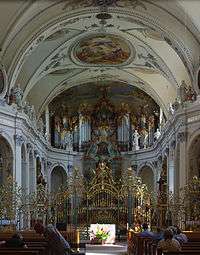Fischingen Abbey
Fischingen Abbey (Kloster Fischingen), now Fischingen Priory, is a Benedictine monastery situated in Fischingen in the Canton of Thurgau, Switzerland, on the upper reaches of the Murg, a tributary of the Thur. It was founded in 1138, dissolved in 1848 and re-founded as a priory in 1977.
History

The abbey was founded in 1138 by Ulrich II, Bishop of Constanz as a private episcopal monastery, with the intention that it should offer shelter and hospitality to pilgrims on their way from Constanz to Einsiedeln Abbey.
The hermit Gebino was appointed the first abbot. In only six years he had had built a bell tower, accommodation for both monks and nuns, and a guesthouse. At its high point in about 1210, Fischingen had about 150 monks and 120 nuns. The "Vogtei" (protective lordship) over the abbey belonged to the Counts of Toggenburg. Saint Idda of Toggenburg, who lived in a cell of the abbey in about 1200, is buried in a chapel off the abbey church.
From 1460 the abbey was under the authority of the administration of Thurgau in the Old Swiss Confederacy.
During the Reformation, the abbey was dissolved for several years, when in 1526 the abbot and the four remaining monks converted to the Reformed beliefs. The abbey was reopened however on the initiative of the Roman Catholic townships of the Old Swiss Confederacy.
In the 17th and 18th centuries the premises were rebuilt in the Baroque and Rococo styles. Between 1685 and 1687 a new abbey church was constructed, and in 1705 a new chapel dedicated to Saint Idda. In the 18th century part of the monastic premises was rebuilt, but could not be completed because of the abbey's accumulated debts.
Fischingen Abbey was dissolved on 27 June 1848 by the Grand Council of Thurgau.
After dissolution
The abbey premises were sold in 1852 to a textile factory. Later a business and trade school was set up here. In 1879 the buildings were acquired by the Catholic voluntary society "Verein St. Iddazell", who established in them the St. Iddazell orphanage.
After the repeal in 1973 of the so-called "Article of exception" ("Ausnahmeartikel") in the Swiss constitution, which forbade the opening of new monasteries and the re-establishment of old ones, Fischingen was reopened as an independent priory in its former premises in 1977.
In 1602 Fischingen joined the then newly established Swiss Congregation, now part of the Benedictine Confederation, and re-joined on its re-foundation in 1977.
Although several Benedictine monks still reside in the main building, it is now a high class hotel which specialises in seminars.
Guided tours must be pre-booked around this large and interesting building.
The excellent restaurant is open to non-residents.
The whole place is immaculate and the attached Catholic church is a place of extraordinary beauty.
A unique feature in the church is an ancient stone sarcophagus with small opening in base into which the faithful put their feet while making peace with their Maker.
New to the abbey in 2015 is the Brauerei Kloster Fischingen, located in an outbuilding. Their bottled ales are available in the restaurant.
External links
- Fischingen Abbey website (German)
- Benno Schildknecht: Fischingen Abbey in German, French and Italian in the online Historical Dictionary of Switzerland, 2005-03-10.
- Photo of monastic buildings
Coordinates: 47°24′43″N 8°58′06″E / 47.411927°N 8.968282°E